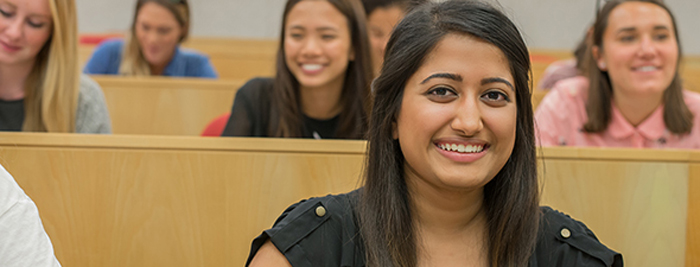FIMS News
Contact Information
Dean's Office
fimsadmin@uwo.ca
519-661-3720
FIMS & Nursing Building
Rm 2050
Graduate Student Services
fims-gradservices@uwo.ca
519-661-4017
FIMS & Nursing Building
Rm 2020
Undergraduate Student Services
macs@uwo.ca
519-661-3542
FIMS & Nursing Building
Rm 2001
Blazing a new trail - Master of Media in Journalism & Communication

In September 2015, the Faculty of Information and Media Studies at Western University will blaze a new trail in graduate education with the launch of the Master of Media in Journalism and Communication program (MMJC).
Unique in Canada, the MMJC program will fuse traditional journalism education with communications skills in a newly-designed curriculum that will give graduates a broad range of abilities in both fields.
Mark Rayner, MMJC program coordinator, explains that the new program is a response to changes in the profession, and will allow students to take advantage of a drastically different media world than what previous generations faced upon graduation.
“As you know, the media landscape has changed radically in recent years, altering the career paths of today's journalism graduates and in turn, that has had an impact on the appeal of our current program. At Western, we see this as both a challenge and an opportunity,” says Rayner.
“We believe this approach will help future grads to be nimble, adaptable and more successful in their future careers.”

Western has a long history of exceptional journalism education, dating back to 1945, when an undergraduate degree was first offered. Since 1974, the degree has been conferred as a Master of Arts in Journalism. The program has produced a long line of prominent journalists, from Adrienne Arsenault, to Scott Russell, John Ibbitson, Colin Perkel, Avis Favaro and many others.
Rayner says that the MMJC program will take the best components of the Master of Arts in Journalism program – its strong tradition of story-telling and critical understanding of media – and incorporate communications education. There is a recognition that the fields of journalism and communications are becoming increasingly interdependent, he explains.
“Public relations officials have more and more influence on journalists, so it’s increasingly important for journalists to understand the role of communications. Conversely, professionals working in public relations, media relations and other communications fields need to understand how to incorporate the same media techniques that journalists use into their own work.”
In order to give students exposure to all the vital components of both journalism and communications – but also let them pursue their own interests – the curriculum is divided into three terms.
“In the first term, we build up the basic skill sets our students will need to progress – storytelling, concise writing, interviewing, research, and multimedia skills,” says Rayner.
Students will take introductory courses for both communications and journalism, as well as courses in information law, social media, digital production and video and audio story-telling.
The second term will allow students to specialize, depending on their own preferences. They can pursue more advanced work in communications or journalism, and there is a wide selection of electives to choose from covering topics like data mining, magazine writing and political communicating and reporting. Students will also tackle ethics and critical theory in the second term.

In the final term, Rayner says that students will go on a 10-week internship, working with the media in journalism or communication – whichever is of more interest to them – where they will have the opportunity to hone their skills and put what they have learned in class and the lab to practical use.
“That rich experience is capped off by a final 4-week project that will allow our students to demonstrate what they have learned. We plan to end the year with a group ‘showing’ of these projects so that we can learn from one another too.”
With the successful completion of all three terms, students should have a wide variety of skills to draw from, and the critical thinking chops to back up their decisions.
Rayner notes that while stories may need an anchoring medium, be it text, video or audio, it is critical for graduates today to understand how to integrate them and build synergy in their story-telling. The curriculum will also help them understand the underlying principles of media production and give them the chance to think deeply about how media works culturally, technologically, and socio-economically.
There is no doubt that media technologies and methods of content production will continue to change rapidly in the foreseeable future. At its core, the MMJC program is designed to give graduates the ability to shift with the changes.
“Our goal is not only to help prepare them for work when they graduate, but to give them the strategic and contextual thinking they'll need to be adaptable as the media landscape continues to evolve.”
Visit the MMJC program section for more information.






